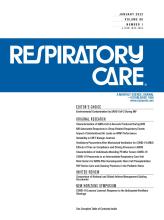This article requires a subscription to view the full text. If you have a subscription you may use the login form below to view the article. Access to this article can also be purchased.
Abstract
BACKGROUND: Cardiopulmonary exercise testing is an increasingly common test and is considered the accepted standard for assessing exercise capacity. Quantifying variability is important to assess the instrument for quality control purposes. Though guidelines recommend biologic control testing, there are minimal data on how to do it. We sought to describe variability for oxygen consumption (V̇O2), carbon dioxide production (V̇CO2), and minute ventilation (V̇E) at various work rates under steady-state conditions in multiple subjects over a 1-y period to provide a practical approach to assess and perform biologic control testing.
METHODS: We performed a single-center, prospective study with 4 healthy subjects, 2 men and 2 women. Subjects performed constant work rate exercise tests for 6 min each at 25–100 W intervals on a computer-controlled cycle ergometer. Data were averaged over the last 120 s at each work rate to reflect stepwise steady-state conditions. Descriptive statistics, including the mean, median, range, SD, and coefficient of variation (CoV) are reported for each individual across the 4 work rates and all repetitions. As these data were normative, z-scores were utilized, and a value greater than ± 1.96 z-scores was used to define significant test variability.
RESULTS: Subjects performed 16–39 biocontrol studies over 1-y. The mean CoV for all subjects in V̇O2 was 6.59%, V̇CO2 was 6.41%, and V̇E was 6.32%. The ± 1.96 z-scores corresponded to a 9.4–18.1% change in V̇O2, a 9.6–18.1% change in V̇CO2, and a 9–21.5% change in V̇E across the 4 workloads.
CONCLUSIONS: We report long-term variability for steady-state measurement of V̇O2, V̇CO2, and V̇E obtained during biocontrol testing. Utilizing ± 1.96 z-scores allows one to determine if a result exceeds expected variability, which may warrant investigation of the instrument.
Footnotes
- Correspondence: Thomas W DeCato MD, Harbor-UCLA Medical Center, 1000 W. Carson Street, CDCRC Box 402, Torrance, CA 90509. Email: tdecato{at}ucla.edu
The authors have disclosed no conflicts of interest.
Drs DeCato and Hegewald presented a version of this paper at the ATS International Conference 2019, held in Dallas, Texas, May 17–22, 2019.
Supplementary material related to this paper is available at http://www.rcjournal.com.
- Copyright © 2023 by Daedalus Enterprises
Pay Per Article - You may access this article (from the computer you are currently using) for 1 day for US$30.00
Regain Access - You can regain access to a recent Pay per Article purchase if your access period has not yet expired.











